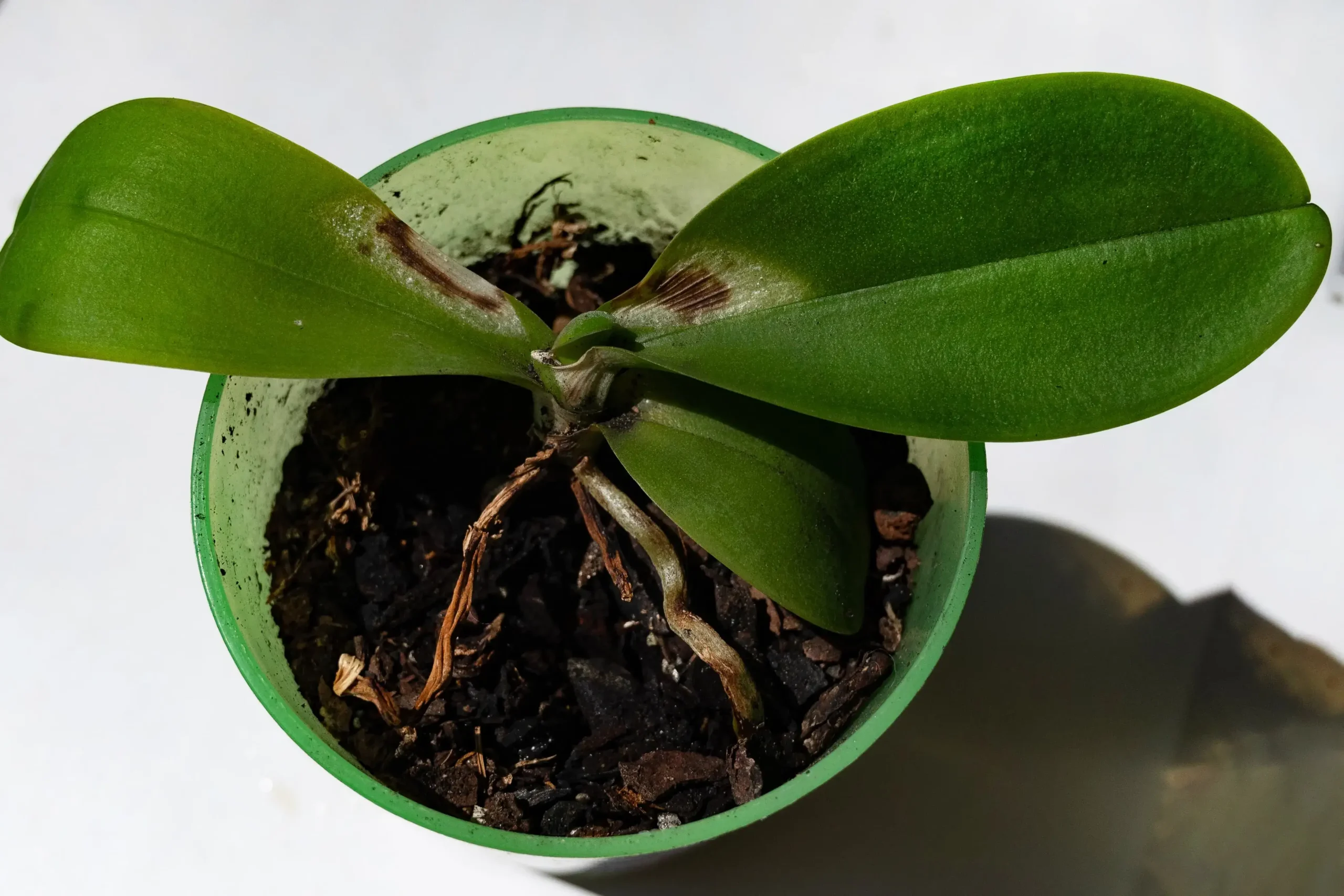Have you noticed dark spots on your orchids and wondered what’s going on? They can be black, brown, yellow, purplish, or maybe sunken or watery blisters. You may also notice a foul smell, liquid secretions, or lesions.
Whatever the case, you need to identify the issue and treat it. Now, it may not be easy, but I’ll guide you step-by-step through the process. So, don’t panic, and relax first.
Also, some hybrid orchid species exhibit slight natural pigmentation. And there’s a chance that you may have noticed it today. So, there may be nothing wrong with your plant.
But if there are prominent dark spots that grow in size or spread on leaves, water-exuding lesions, and discoloration in the leaf, it’s a sign of concern.
So, to treat them, first understand that leaf spots are major symptoms of bacterial or fungal diseases. But sometimes, factors like increased sunlight or watering may also cause it. Pathogenic diseases spread due to splashing water, high humidity, warm temperatures, and unsanitary regimes.
Although orchids are more resistant to diseases than other houseplants, exposure to pathogens is still possible. So, start with the orchid disease identification from the following table, and read details of the issue you think is happening with your orchid.
Table of Contents
| Cause | Symptoms | Treatment | |
| Bacterial Infections | Bacterial Soft and Brown Rot | Water-soaked brown or black spots. Slimy leaf with a bad odour. | Cut off the diseased leaf and disinfect the rest of the stem. Use hydrogen peroxide, Physan 20, quaternary ammonium compounds |
| Bacterial Brown Spot | Dirty green watery lesions surrounded by a yellow colour that turns brown. | Isolate the plant. Remove the infected leaf, disinfect the rest of the stem. Use hydrogen peroxide or Kocide. | |
| Crown Rot | Yellow-brown spots underside of the leaf. Slow or no new growth. | Isolate plant and remove infected parts. Disinfect the rest and use hydrogen peroxide or pool algaecide. | |
| Fungal Infections | Black Rot | Cause damage to young foliage. Brown watery spot on leaf that secrete liquid if pressed. | Discard the highly infected orchid if not valuable. Otherwise remove damaged tissue, drench it in broad-spectrum fungicides such as BanRot, Dithane M-45, Terrazoleand. Repot in a fresh potting mix, isolate it for 2 months. |
| Anthracnose | Leaf tips turn Brown and sunken. Well-defined discoloration with overlapping ring patterns. | Isolate the plant, remove infected parts. Use broad-spectrum fungicide with chlorothalonil or Physan 20. | |
| Cercospora Leaf Spot | Yellow spots underneath the leaf eventually turn purplish black. | Remove the infected leaf. Disinfect the rest of the stem Use Thiophanate Methyl. | |
| Guignardia Leaf Spot | Tiny dark purple lesions along the veins of the leaf. It can be on any side of the leaf and merge into a patch. | Cut off the infected leaf, disinfect the rest of the stem. Use Boscalid or Pyraclostrobin. | |
| Phyllosticta Leaf Spot | Tiny yellow and sunken spots on the leaf or pseudobulb. | Remove the infected leaf and disinfect the rest. Use Boscalid or Pyraclostrobin. | |
| Physical Damage | Sunburn | Brown patches surrounded by a yellow border. | No treatment. Remove the damaged leaf. |
| Edema | Corky blisters on leaves. | No treatment. Remove the damaged leaf. |
Bacterial Infections
1. Bacterial Soft and Brown Rot (Pectobacterium)
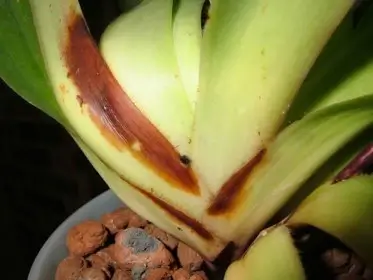
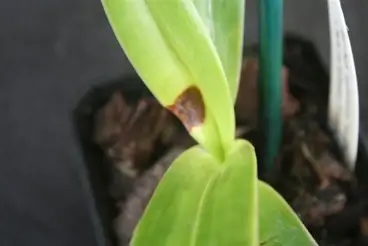
Bacterial brown rot is common orchid disease caused by various species of Pectobacterium (Erwinia). Bacteria damage the plant cell wall and dissolve it, resulting in the death of plant tissues.
If a bacterial infection is left untreated, it spreads to other leaves and parts of orchids, such as pseudobulbs and roots, and plants will die.
Symptoms
The first sign of infection is damp-looking spots on the orchid leaves surrounded by yellow halos, and the leaves become slimy. You may also sense a foul odor from the plant due to infected tissues.
The severity of symptoms depends upon different species of orchids:
- In Dendrobium, the symptoms appear as yellowing of leaves, drooping, and the infected area becoming black.
- In Phalaenopsis, the leaves rot within 2-3 days, the disease spreads quickly and chances of recovery will decrease.
- In vanda orchids, the leaves have brown or black spots and are wilted.
In short, the water-soaked brown spots that spread quickly are key identifiers of bacterial presence.
Treatment
Treating bacterial brown and soft rot involves using some bactericides or cutting down the infected leaves. Before treatment, you must wear gloves and sterilize the scissors.
- Now, carefully cut the infected leaves and dispose of them properly. If the infection affects only half of the leaf, cut 1 inch below it. The remaining healthy portion will grow back.
- Thoroughly examine the orchid and carefully cut all discolored or contaminated foliage.
- The next step is to disinfect the infected orchid leaves with bleach or hydrogen peroxide 3%. These are easily available at local pharmacies. Spray them all over the orchid leaves and nearby plants.
Orchid growers prefer cinnamon to treat orchid wounds. A small amount of cinnamon is applied to the cut parts. Cinnamon speeds up the healing process, prevents reinfection, and dries the area quickly.
- You can use bactericides that contain quaternary ammonium and Kocide (Copper or Physan compounds). Spray them only on infected plants.
Prevention
Bacterial diseases in orchids are mainly caused by high humidity, high temperature, and excessive watering. For future prevention of bacterial disease, follow the given steps.
- Adjust Humidity: Relocate the orchid to a dry environment. The ideal humidity for orchids is 40-70% and increasing it is not beneficial. You can also install a hygrometer to monitor humidity.
- Improve Ventilation: Place your orchid in front of fans for a few hours, or open windows to improve the ventilation in the surrounding area.
- Control Temperature: Bacterial growth sustains in hot and warm conditions. So, maintain the temperature near the orchids.
- Watering Routine: Avoid overhead watering or frequent misting of the orchids, as these provide a medium for bacterial growth.
- Anti-Bacterial Spray: It is recommended to use an anti-bacterial spray (copper-based) during hot and humid weather. It is just an extra preventive measure. But you should not use it on blooming plants or Dendrobium.
2. Bacterial Brown Spot (Acidovorax)
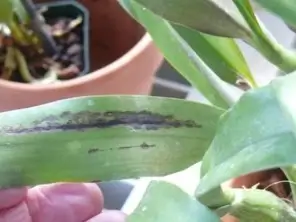
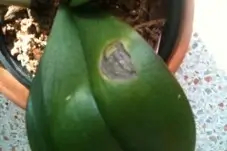
Bacterial brown spot is another infection in orchids and the culprit behind this is Acidovorax (Pseudomonas). If orchids have any wounds or scratches, it provides a way for bacteria. Although various orchids can get infected by bacteria, Phalaenopsis is more prone to brown spots.
However, multiple cases of this infection in other species, such as vanda, cattleyas, dendrobium, and zygopetalum, are also reported among the orchid community.
Symptoms
Acidovorax presence can be confirmed if the orchid exhibits the following symptoms:
A water blister or lesion anywhere on the leaves, initially dull green, enlarges, spreads, and eventually turns brown.
The spots may be haloed by a yellow color on the young leaves. Sometimes a liquid dribbles from the leaf tip due to bacterial activity with an unpleasant odor.
Treatment
Although the disease spreads quickly in the leaves, it is rarely fatal. You need to cut down the infected leaves.
Then, use 3% hydrogen peroxide to kill the bacteria. It is better to sterilize nearby orchids too, because bacteria can spread easily.
You can use bactericides, copper fungicides, pool algaecide, Physan 20, or Consan. All are equally effective but are not suitable for Dendrobium or blooming stage.
- Mix 2 tablespoons of Physan 20 in 1 gallon or as per the manufacturer’s guidelines. Spray on each leaf, but protect any flowers from chemicals.
Alternatively, you can use hydrogen peroxide or a DIY hack of Cinnamon powder to prevent infection. But do not use it on roots as it also has desiccating powers.
Prevention
As told before, bacterial infections are majorly caused by changes in environmental conditions such as humidity, temperature, and poor air circulation.
So, it is advised not to leave water on the leaves for a longer period to prevent the recurrence of Bacterial Brown spots. Furthermore, isolate the infected orchid from the other plants, as bacterial infections can spread easily.
Moreover, focus more on orchid hygiene. Once a month, wipe the leaves with horticultural oil or a mixture of 1 tablespoon of glycerine and castile soap in a gallon of water.
But whatever product you use, the infected part must be cut first. Lastly, always read the label and instructions carefully.
3. Crown Rot (Pseudomonas)
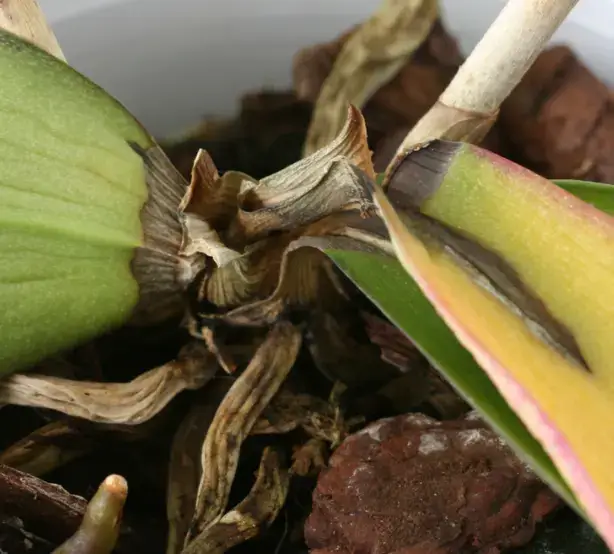
Crown rot is a nightmare for an orchid grower because of the serious consequences it brings. The disease spreads over night, leaving a dead orchid in front of you. Crown rot is mainly caused by bacteria Pseudomonas but also by some species of fungi.
Another reason is excessive moisture due to overhead watering or frequent misting. If water accumulates inside the layering of leaves or crowns, bacteria will grow there, causing the tissue to rot.
Symptoms
The symptoms of crown rot might be considered part of plants’ natural cycle, such as dropping old leaves. But if this is happening to young growth, you must pay attention to it.
- You may notice yellow-brown spots at the base of the leaf or underneath the leaves, which are unlikely to be noticed.
- Usually, the lower young leaves are affected first.
- Initially, the green leaves of the orchid turn yellow, then brown, and eventually drop off, leaving behind the base black or brown.
- The silvery coating of aerial roots turns bright green with rotting spots.
- Slow or no new leaf growth from the center of the crown.
Treatment
When you notice the symptoms, grab a sterilized blade or scissors and remove the infested area immediately. Make sure the remaining portion only consists of healthy tissue. But it’s better to cut the infected part and repot the bulbs in fresh soil medium.
Considering the disease’s seriousness, DIYs will not help, so you need a strong chemical (bactericide or fungicide) to tackle this infection. Physan 20 and copper fungicides are reliable. Spray them on plants and soil every two weeks.
However, the product type varies with the variety of orchids you are growing. It is advised to follow the manufacturer’s directions for the chemical.
Prevention
The prevention of crown rot is easier than its treatment. You need to:
- Make sure the plant is not drenched in moisture.
- Remember to water only the soil and not the leaves.
- If orchid leaves get wet, dry them out by placing them in front of a fan or using tissue paper. Don’t let the water stay on the leaves.
- Improve the air circulation.
- Frequently checks on the crowns of orchids for early detection of infection.
- Don’t place ice cubes on the leaves.
Fungal Infections
Fungi are harmful as much as bacteria are for orchid health. These are mainly caused by plant-damaging oomycetes (water molds). Their proper identification and timely treatment are needed to save the orchid.
4. Black Rot (Pythium and Phytophthora)
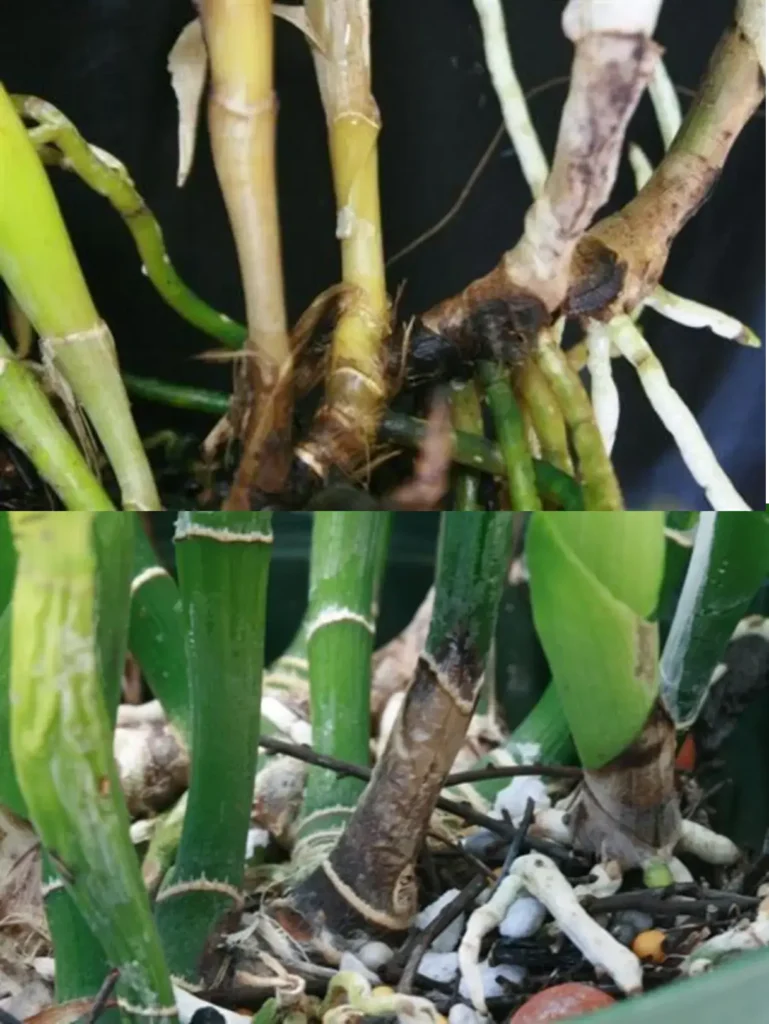
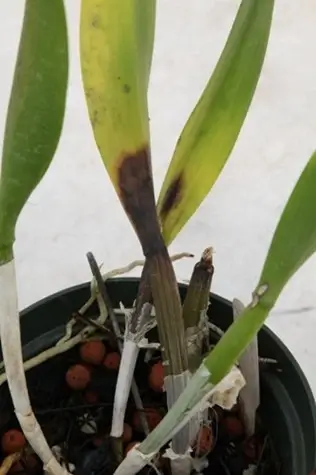
Black Rot is a fungal disease caused by Pythium or Phytophthora. It spreads rapidly under favorable conditions, and if it reaches the crown of an orchid, it results in root rot and plant death.
Symptoms
The symptoms mainly start at new growth or lead of the orchid. At first, you may notice a small watery brown spot on the leaf, which enlarges and turns black, followed by a yellow margin. The lesion may secrete liquid if pressed. The lesions can also be developed on roots and stems.
Treatment
Here, you need to make a choice, whether the plant is precious enough or not. Because removing the diseased leaf is not enough. You should discard the highly infested plant because black rot is a highly contagious infection that spreads from one plant to another.
But if you want to save it, separate it from other plants, and use strong fungicides.
- Wear gloves before making direct contact with the plant and isolate it. The first step of treatment is to cut the entire affected part with a sterilized tool and dispose of it.
- After that, drench the remaining part in a fungicide.
- Products like Physan 20, Subdue, BanRot, Dithane M-45, and Terrazole are highly effective against fungal diseases but need a little care and precautions. Fungicides will inhibit the growth of fungus by destroying its cell wall.
- Always read the manufacturer’s instructions before use.
- Now report the remaining foliage in a new pot with fresh potting mix.
- Isolate it for at least 2 months to prevent recurrence of infection.
Box: Fungicides are classified into two types: systemic and contact fungicides. It is recommended to use systemic fungicides first, as they will be drawn into the plant system and work by killing any pathogen from inside. After a few days, use a contact fungicide for external protection and prevention of spores. To prevent fungicide resistance, alternate the fungicide.
Prevention
Fungals are uninvited guests but have specific host requirements, such as moisture and high humidity. Avoid overhead watering of orchids and wait for the soil to dry up between waterings. Furthermore, maintain good air circulation to avoid damp conditions.
Fungus (oomycetes) form zoospores that can travel easily in water. Therefore, splashing water from contaminated plants, unsterilized tools, pots, or potting mix are a few ways fungus can spread among all plants. Lastly, at the first sign of disease, quarantine the orchid and disinfect all the nearby plants.
5. Anthracnose (Colletotrichum)
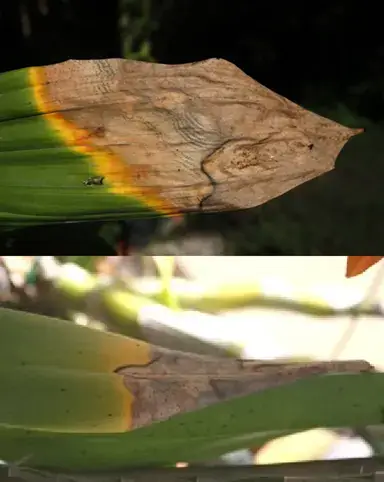
Colletotrichum is a genus of fungi that consists of major plant pathogens. One of the common diseases they cause in various plants is Anthracnose. This fungal disease mainly affects the aerial parts of orchids, specifically leaves and flowers.
Symptoms
Symptoms of Anthracnose begin as black spots or blemishes on the leaf’s tips that move downwards. This is followed by prominent discoloration and overlapping circles on the leaf. The affected area may appear dry, while the rest of the leaf will be fine.
However, the symptoms of Anthracnose on the flowers are different from those on the leaves. At the start, small, dark, liquid blisters are formed below the mature sepals and petals, eventually covering the whole flower.
Treatment
Remove any infected part with sanitized tools and discard it properly. Use fungicides with the active ingredient chlorothalonil and spray the whole plant. Always wear protective gear, gloves, and masks before using fungicides.
Prevention
Colletotrichum thrives well under low light, warm weather, and humid conditions. To improve air circulation, relocate the plant to a brightly lit area. Furthermore, lowering the temperature and improving plant sanitation will help prevent the further spread of the fungus.
6. Cercospora Leaf Spot (Cercospora)

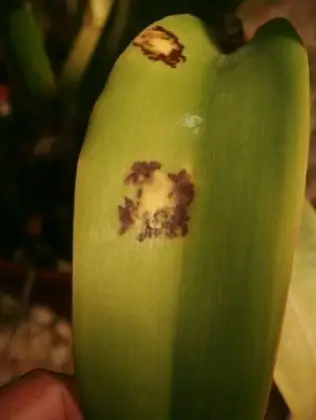
Cercospora is a fungus known for its pathogenic diseases of various plants and crops. Unfortunately, orchids are also included in its host preference. The disease caused by Cercospora is a leaf spot, and the most common symptoms are listed below.
Symptoms
Cercospora causes yellow spots on the undersurface of the leaf. If you touch them, they feel a little bit sunken. After a few days, they spread to the upper surface, forming purplish-black circular or irregular borders. These patterns cover the entire leaf, and the leaf falls off from the base of the stem.
During the initial stage of the disease, only the leaf’s color diminishes or disturbs, but as the fungus progresses, these spots cause the leaf tissue to die.
Treatment
When diagnosed early, it’s not fatal, but it can spread rapidly. Therefore, quarantine your plant at the first sign of infection.
Remove infected plant parts with sterilized pruners or blades and dispose of them by burning them.
The next step is to use commercially available fungicides with the active ingredient chlorothalonil, thiophanate methyl (Epoxiconazole). Spray thoroughly on the infected areas, especially on the leaf crevices.
Always wear protective gear (gloves, masks) before directly contacting the chemicals and follow the manufacturer’s guidelines.
Prevention
Cercospora prefers a humid environment, so remove wetness from the leaf surface after watering. Place your plants in an area with enough sunlight or ventilation.
7. Guignardia Leaf Spot (Guignardia)

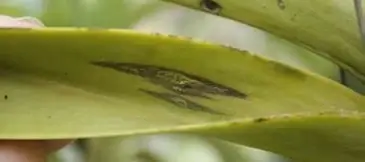
Guignardia Leaf spot disease is most common in warm climates but is found worldwide. Dendrobium and vanda orchid are more prone to this fungus. This disease is also known as Phyllosticta because of two different sexual stages of the same fungus.
Symptoms
The symptoms of the disease appear on any side of the leaf as tiny, oval, dark purple spots along the veins of the leaf. These spots turn purplish black and often merge into a large lesion that covers half of the leaf. In a few cases, black spores develop, which feel abrasive and rough upon touch. Severe infection results in defoliation and weakening of orchids.
Treatment
Cut off all infected parts of the diseased orchid with a sterilized tool.
Then use hydrogen peroxide or fungicides. Both are equally beneficial in this case.
Boscalid and Pyraclostrobin are broad-spectrum fungicides that prevent spore formation on the plant. So, you can use them for this disease. However, you can also use fungicides that contain copper and quaternary ammonium compounds.
Prevention
Guignardia leaf spot is an indication that the plant is living in a drenched environment. So lower the humidity and wipe the wet leaves after watering. Moreover, use sanitized tools and pots, and relocate the plant in a ventilated and dry area.
8. Phyllosticta Leaf Spot (Phyllosticta capitalists)
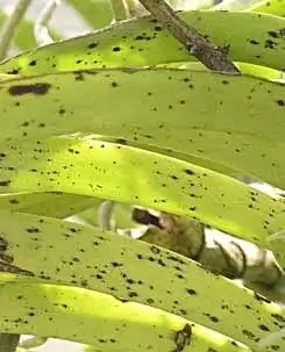
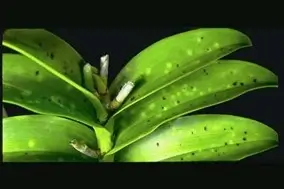
Phyllosticta leaf spot is caused by a fungus, Phyllosticta capitalensis. The disease spreads easily under warm and humid conditions. It affects a variety of orchids, including Cattleyas, Dendrobium, and Vandas. This disease is also known as Guignardia because of two different sexual stages of the same fungus.
Symptoms
Phyllosticta Leaf spot symptoms can appear as either leaf or pseudobulb, causing unpleasant black or brown spots. The signs of this disease are the formation of tiny yellow spots on any side of the leaf. With time they elongate and become sunken.
As the fungi progress, the spots become more visible, with a proper red to purple margin and black sporting bodies in the center of the eye. Eventually, these spots merge into large irregular areas that may cover the whole leaf. The damaged tissue will cause the premature dropping of leaves.
Treatment
Get rid of the infected plant part with sterilized pruners or blades and disinfect the healthy tissue. You can apply the same fungicides, such as copper, thiophanate-based, and Ferbam to treat Guignardia. Make sure to spray the whole plant and do not water on the same day you apply the fungicide. Also, it needs repeated applications to get rid of the fungus.
Prevention
Phyllosticta indicate that the orchid is sunlight deficient so adjust light conditions to prevent further spread of disease or recurrence. Fungus prefers dark, humid, and warm environments, so frequently check the growing conditions of your plants.
Isolate the infected plants from the healthy ones to stop the disease from spreading. Allow adequate air circulation around the plants to prevent moisture build-up. Also, take plant sanitation seriously, as sometimes it may be the root cause of the disease.
Physical Damage
Orchids are delicate and susceptible to various physical damage caused by sunlight, unbalanced watering, or growing conditions. Some conditions maybe due to physical damage to your plant.
9. Sunburn

Orchids need an adequate amount of sunlight to grow well but at the same time, they are quite sensitive to seasonal changes and temperature. Whether you place the orchids indoors or outdoors, you should not expose them to direct sunlight.
Prolonged exposure to direct sunlight comes with serious irreversible consequences such as sunburn. And unlike humans, orchid sunburn leaves cannot be treated with aesthetic procedures.
Symptoms
The symptoms of sunburn appear as black, yellow circular spots on the upper side of leaves, generally where the area is most exposed to sunlight. These black spots differ from bacterial and fungal disinfection and look like scorched blotches.
As time passes, these scars fade, and the damaged area looks like a yellowish, white spot surrounded by healthy tissues.
Treatment
This condition cannot be reversed. It means you cannot cure the already burned leaves because they are not sick but dead.
But here’s the good news: You don’t need to cut off the whole leaf. Just cut the scars and spotting area from the orchid. Then, use cinnamon on the cut portion to protect it from potential pathogens and pests.
Prevention
- Relocate the orchid to a bright but indirect sunlight area.
- Don’t suddenly change the position of the orchid. Gradually increase the sun exposure over a period of 2-3 weeks. This will prevent any shock to the plants, and they will adapt to the new environment easily.
- If you are growing orchids outdoors, place them under a shade cloth.
10. Edema
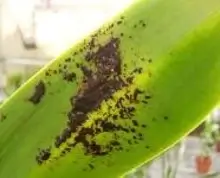
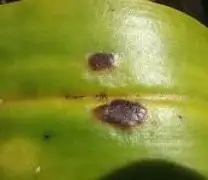
In this condition, the roots absorb more water than is lost through leaves by evapotranspiration. As a result, the plant cells swell and form lesions on the leaves. These corky blisters remain on the leaves till they fall off as part of the natural cycle.
Symptoms
The appearance of green to brown blisters on the leaves that are unsightly and feel leathery upon touch. These blisters are harmful for overall orchid health and will lower plant appeal.
Treatment
There is no treatment to cure the blister formation.
Prevention
Orchids are sensitive to watering regimes, both underwatering and overwatering damage the plant. It would benefit orchids if you maintain a balance in watering conditions. Consider following the simple steps given below:
- Water the orchids early in the morning so that the roots have enough time to absorb water and dry. Only water the orchids when the topsoil is completely dry.
- Reduce watering on humid, rainy, and cold days.
- Do not water the orchids frequently in the fall because they are not actively growing during that span.
- Ensure proper drainage, and do not let the water stay in the pot (soil medium).
Preventative Measures for Future
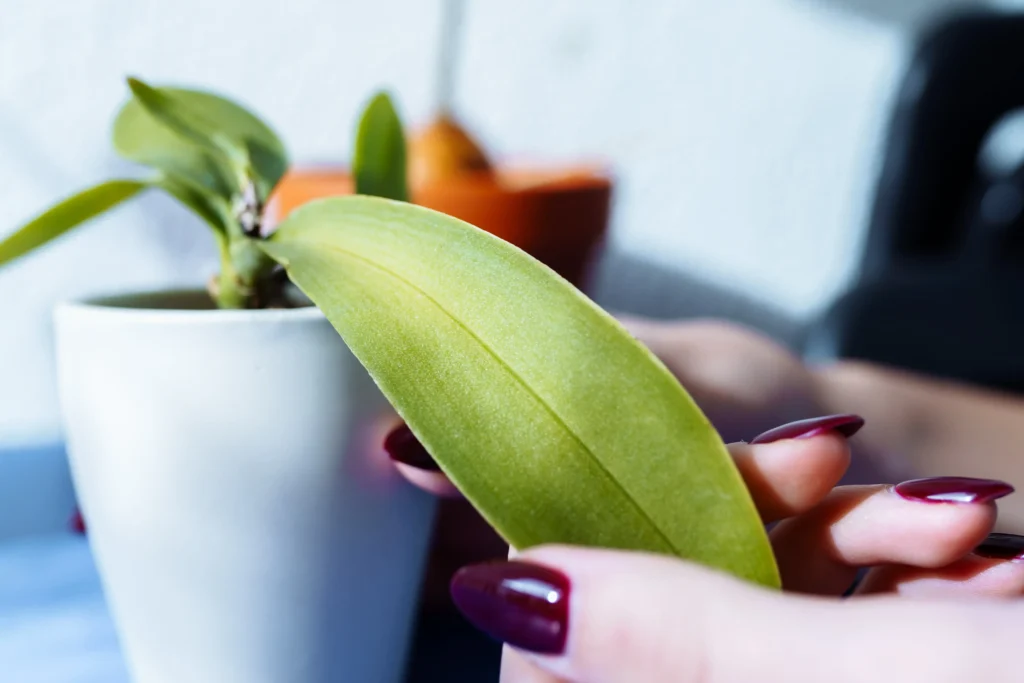
“A danger foreseen is half avoided.” Therefore, it’s easier to prevent diseases than to treat them. If you grow orchids in suitable conditions and care them properly, they are less likely to get infected by pathogens.
But if you live in a climate where your orchids are susceptible to diseases, you should strictly follow preventive measures, including:
1. Optimal Sanitary Practices
Maintain optimal sanitary practices around all of your plants. Always use sanitized tools for pruning, and disinfect the pots and shelves often to avoid future infection.
2. Purchase Healthy Orchids
Sometimes you may wonder that despite all the care and perfect growing conditions, why plants keep getting infected. This is because the majority of pathogens invade your greenhouse from outside.
So, thoroughly inspect the plant before buying and purchasing a disease-free healthy plant. Moreover, isolate the newly purchased orchid for 3-4 weeks, it will give enough time for pests or pathogens to show up, and any possible disease will be visible during that period.
You can alsoseparate your orchids from other plants because orchids prefer slightly different growing conditions.
3. Watering Balance
Only water the orchids when the top 2-inch soil is dry out completely to prevent root rots. Also, pour water only on the soil, not the crowns or leaves. Read more about my watering guidelines.
4. Good Air Circulation
Whether the orchids are outdoors or indoors, ensure proper air circulation between and around the plants. You can also put the orchids before a fan for a few hours.
5. Adjust Humidity
40-70% humidity is ideal for the proper growth of orchids. Anything higher than this limit will make the orchid susceptible to bacteria and fungi. Avoid overhead watering, frequent misting, or leaf wetting on the orchids. But if the leaves get wet accidentally, don’t panic, dry them with the help of tissue. You can also install a hygrometer to check humidity and adjust it.
6. Stable Conditions
Orchids are sensitive beings. Sudden changes in temperature, sunlight, and seasonal shifts will shock them. To avoid this issue, take precautionary measures beforehand and maintain a steady temperature. Also, do not suddenly relocate the orchid to a new place. Slowly expose it to new conditions so that it’s easy for it to adapt to its new home.
7. Organic Fungicides
Pathogens easily infect unhealthy plants, wounded leaves, or foliage. So, if you have pruned a plant or removed any leaf, it is recommended to use cinnamon on the freshly cut area to prevent infection. Cinnamon is considered a natural antifungal with desiccating properties, but don’t use it on roots. Also, occasionally use horticultural oil or neem oil on all orchids to avoid infections.
8. Weekly Inspection
Bacterial and fungal infections spread quickly. So, maintain ideal conditions, and inspect your plants weekly for early detection of any pathogen. Also, dispose infected leaves properly by burning them. Usually, people throw it in a leaf pile in their garden or bin. Both places give bacteria or fungi a welcoming environment for further spore formation.
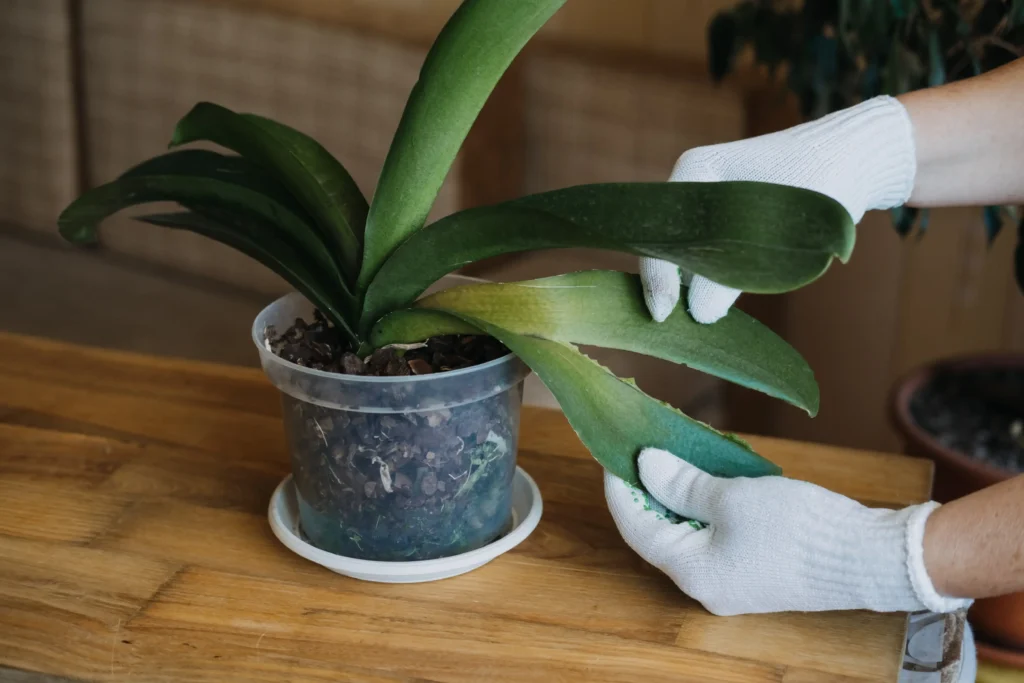
FAQs
How do I treat black spots on my orchid leaves?
The first step of treatment is to cut off the leaf with a black spot immediately. After that, spray it with a suitable fungicide or diluted Hydrogen peroxide. If the plant is highly infected, it is advised to drench it in fungicides.
What do brown spots on orchid leaves mean?
Brown spots on orchid leaves are mainly caused by bacteria or sometimes fungi. Both cause contagious diseases that spread rapidly. You should immediately quarantine the infected orchid, cut off the damaged part, and drench the remaining stems in antibacterial or antifungal.
What is the best fungicide for orchids?
Hydrogen peroxide is considered the best fungicide for orchids and is easily available in pharmacies. Besides it, Physan-20 and products with the active ingredient chlorothalonil are highly effective against fungus. But if you don’t like chemicals, you can use cinnamon instead.
What is a natural antifungal for orchids?
Cinnamon is considered the best natural antifungal and is loved by orchid growers. Cinnamon is a natural desiccant (dries out the wet area) and prevents infection.
How do you save a browning orchid?
Browning orchids are caused by several factors, such as prolonged exposure to sunlight, which scorches the leaves of healthy plants. Also, lack of humidity, cold weather, over or underwatering, pests, or disease may cause brown leaves. You can save your orchid when you identify the root cause. A general treatment is to cut the damaged part and disinfect the plant for additional protection.
Should I remove leaves with black spots?
Yes, you should immediately remove the leaves with black spots to stop the fungal infection. Also, dispose of them by burning them.
Final Thoughts
Orchids are renowned for their delicate nature and exquisite beauty but if you encounter bacterial and fungal diseases, don’t panic. Relax and take appropriate steps.
Pathogenic diseases are highly contagious. If left unchecked, they can quickly destroy the whole plant. Many orchid diseases resemble each other, so carefully observe the symptoms for a suitable treatment.
Generally, it is advised to discard highly infected orchids, such as those with black rot, because the chances of recurrence are higher, and saving them is nearly impossible.
But if the orchid is valuable and you cherish it a lot, you may go for treatment procedures. Although it’s time-consuming, it’s somewhat rewarding, too.
Also, maintain proper conditions near the orchid, such as humidity, ventilation, and optimal temperature to grow healthy orchids and prevent future infection.
Still got some queries? Let me know in the comments below!

